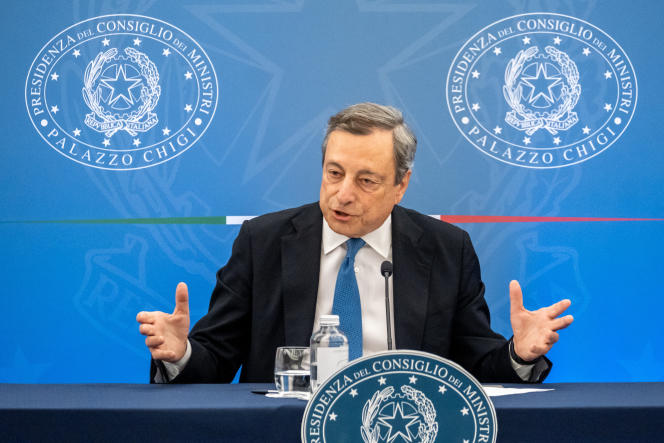Will the turmoil of Italian politics once again plunge the Eurozone into an existential crisis? We are not there yet, but, in Brussels, the scenario is on everyone’s mind. Arrived at the Chigi Palace in February 2021, Mario Draghi submitted his resignation Thursday, July 14, due to a disagreement with one of the parties of the coalition he leads, the 5 Star Movement (M5S, antisystem). President Sergio Mattarella has rejected it, refusing for the moment to let him go, and no one knows what the outcome of this episode will be. “If it does not resolve quickly, this Italian crisis would arise at the worst time for the European Central Bank [ECB],” said Eric Dor, economist at the Iéseg business school.
Since the debt crisis of 2012 and the bailout of Greece, the Peninsula, with its unstable political life and its imposing public debt – more than 150% of gross domestic product – is considered the weak link in the euro zone. Also, the arrival of Mario Draghi to power had been applauded as a miracle in European circles.
Former President of the ECB (from 2011 to 2019), with a solid international reputation, he alone seemed capable of implementing the reforms promised as part of the European recovery plan of 750 billion euros (including 209 billion for Italy), and likely to put the country back on the path to growth. As soon as he took office, the difference between Italian and German ten-year borrowing rates (the spread, considered the barometer of risk) had fallen below 100 basis points (1 percentage point) – an all-time high. seen since 2015.
“Danger Zone”
But the spread has not stopped rising since the start of the war in Ukraine on February 24, and today exceeds 215 points. “I’m not a shield against events, I’m a human being,” Mario Draghi said in May of the rise. The spread even peaked at 245 points in mid-June, when the ECB announced the scheduled end of its support for the economy. “We are approaching 250 points, the danger zone which, in the past, had forced the ECB to intervene verbally to ease the tension”, underline Francesco Pesole and Antoine Bouvet, strategists at ING, in a note on the subject.
A possible departure of Mario Draghi could trigger a wave of concern among investors, tempted to sell the Italian debt they hold – at the risk of pushing the spread even higher. But even if he stays, legislative elections must be held in the country before March 2023 – and perhaps even as early as the fall. “The risk that a new government without Mr. Draghi will take a more confrontational stance towards the European Union is high,” said Franziska Palmas, country specialist at Capital Economics.
Heavily penalized by soaring energy prices
In such a scenario, would the ECB deploy its new “anti-fragmentation” tool (targeted and emergency purchases of public debt), the outline of which should be unveiled on Thursday July 21, to bring Italian rates back down? Nothing is less certain, because the governors of the countries (especially in the North) most worried about the drift of Rome’s public finances would be reluctant. “Absent a stable government and a commitment to certain conditions, the ECB could hardly justify the purchase of new Italian bonds,” add Francesco Pesole and Antoine Bouvet.
In Brussels, as in Milanese business circles very favorable to Mario Draghi, there is a particular fear that the Peninsula, heavily penalized by soaring energy prices, will miss the chance offered to it by the European recovery plan. Namely that of initiating reforms and the energy transition allowing it to break with two decades of sluggish growth, dysfunctions of justice and emigration of young people.














